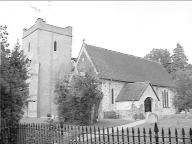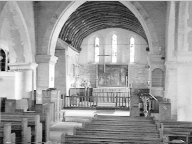![]()

![]()
10. St Mary's Selborne

Every year thousands of visitors flock to the small village of Selborne in North Hampshire, famous for its connection with Gilbert White the remarkable 18th century naturalist and cleric who wrote The Natural History of Selborne in 1789. A very pleasant day can be spent visiting the museum, the church and walking through the beautiful wooded hangars above the village.
Founded in Saxon times and mentioned in the Domesday Book the present church with its sturdy Norman tower and nave, largely dates from 1180. Before entering the church one passes the remains of the famous 1400 years old yew tree so sadly blown down in 1990. A plaque on the church door has recently been erected. It states, 'Near this spot lie the remains of our forbears disturbed by the fall of the great yew in the gale of 25 January 1990. Those who rebuilt this church about 1180 AD may be among them. May they rest in peace.'

Gilbert White Memorial Window, 1920
The church has close connections with Gilbert White who was Curate for many years until his death in 1793. He is commemorated by two stained glass windows. One, erected in 1920, the bicentenary of his birth, shows St Francis preaching to the birds. All those depicted are mentioned in the Natural History. The yew tree, church and the vicarage where Gilbert White was born are also shown. The other window dates from 1993 the bicentenary of his death. The design is most attractive. Three circular panels show foxes, rabbits, a tortoise, a hedgehog, bats, a stoat, a frog, a fish pond, field mice as well as sundry flowers and plants. A green cross with white arum lilies forms the background, the rest of the glass being plain. Underneath are the words, 'For a faithful priest, a humble student of nature, and a writer of genius.'

The chancel, when lit, is of great beauty. Above the altar is a fine Flemish painting showing the Adoration of the Magi. Painted by Jan Mostaert in 1515 it was presented to the church in 1793 by Benjamin White, the brother of Gilbert White. A black slab on the floor commemorates his grandfather, Gilbert White senior, vicar of the parish from 1681 to 1728. The Elizabethan altar rails were brought to the church from St Juliot's Church in Cornwall, whilst on the wall is a fine 16th century Flemish wood carving showing the Descent from the Cross.
The nave is dominated by massive late Norman columns. A separate chapel in the North Transept is now divided from the church by a lovely oak screen dedicated in 1949 as a memorial to the dead of the two world wars.
The six bells in the tower were recast in 1735. Gilbert White recorded the event as follows. 'The day of arrival of this tuneable peal was observed as a high festival in the village and rendered more joyous by an order from the donor that the treble bell should be fixed bottom upward in the ground and filled with punch, of which all present were invited to partake.' The church clock, with its single hand, is one of the oldest in Hampshire, dating from 1678.
Outside the church porch is a stone simply inscribed, 'The Trumpeter' which marks the grave of John Newland a labourer who blew his horn to assemble the agricultural rioters of 1830. In the north east corner of the churchyard can be found the grave of Gilbert White consisting of two small stones and the simple inscription 'G.W. 26 June 1793'.
written by John Symonds
![]() Return to the Summer 1997 Features page
Return to the Summer 1997 Features page
![]() return to Home page and main index
return to Home page and main index
page last updated 20 JULY 1997